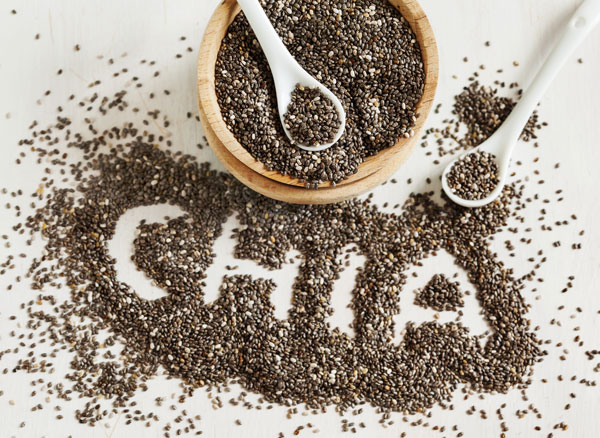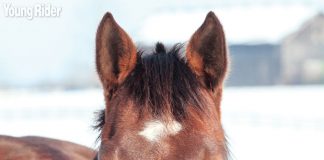
It was back in 2010 at a conference in Denver, Colo., that I came across a booth where chia seeds were being sold as a dietary supplement for horses. I had never heard of chia seeds! Did you know about them 10 years ago?
Chia Seeds Are Tiny
Each one measures approximately 1 millimeter—that’s about 1/25th of an inch! But don’t let that sway you—they offer a powerful nutritional punch. They are high in fiber (42%), protein (18%), vitamins and minerals, and antioxidants, but they are best known for their high essential fatty acid content (both omega 3 and 6).
Chia Seeds Are 30% Fat
This includes the two essential fatty acids, alpha linolenic acid (ALA)—an omega 3, and linoleic acid (LA)—an omega 6. They are present in a highly favorable 3:1 ratio of omega 3 to 6. This ratio comes close to what is naturally found in living pasture grasses. But most commercially fortified feeds have just the opposite ratio, where LA exceeds ALA. That’s because most of them use oils, such as soybean oil (commonly referred to as vegetable oil), corn oil, or safflower oil, all of which are very high in LA. The result is an inverted ratio between these two fatty acids, which unfortunately increases inflammation throughout the body. The way to counteract it is to add a source of omega 3s, such as chia seeds, to improve the ratio and reverse the inflammatory response.
Chia Seeds’ Additional Nutritional Benefits
· Caffeic acid—No, that’s not caffeine. It is a type of polyphenol found in plants that is known for its antioxidant properties and its ability to reduce inflammation.
· Quercetin—This is a biologically active flavonoid that works with vitamin C to provide an “antioxidant team.” It is effective in reducing the inflammation that occurs during allergic responses. It also protects against heart disease and cancers.
· Phenolic Compounds—These include vitamin E and beta carotene. They are potent antioxidants, which scavenge free-radicals and prevent cellular oxidation and disease.
· Mucilage—This is a water-soluble fiber, that holds water 27 times its own weight. It forms a gel when water is added to chia seeds.
· Kaempferol—A flavonoid that not only exhibits antioxidant properties, but also anti-inflammatory, anti-microbial, anti-cancer, as well as neuroprotective and anti-diabetic activities.
How Chia Seeds Can Help Your Horse
Their potent nutraceutical content significantly impacts your horse’s health and vitality by impacting the following conditions:
· Weight Management for Hard- or Easy-Keepers—Their high fat content provides calories for the horse needing to gain weight. But overweight horses also benefit. Their high ALA content lowers circulating insulin levels. In addition, they reduce inflammation created by body fat that can lead to leptin resistance, thereby aiding in weight loss.
· Easing Joint and Muscle Pain—ALA alleviates pain through its COX2 enzyme inhibition, much like the drug firocoxib (Equioxx).
· Ulcer Prevention and Cure—The mucilage and quercetin content of chia seeds helps protect and heal the mucosal lining throughout the stomach and remainder of the gastrointestinal tract.
· Colic Prevention—Chia seeds are often touted to prevent sand colic. While its mucilage content does not actually bind to sand, the gel adds significant bulk to the hindgut. This aids in ensuring that the cecum is full—a necessary condition because its entrance and exit are at the top! Therefore, for sand to reach the top, there needs to be enough digested material to carry it out the exit. By making sure your horse has access to forage 24/7, all day and all night, you’ll ensure a full cecum and reduce the incidence of colic.
· Allergy Relief (both respiratory and skin-related)—ALA is effective in reducing the histamine reaction that impacts your horse’s respiration. It can also benefits horses suffering from chronic airway inflammatory disease. Skin reactions, in particular allergic responses to culicoides (sweet itch), are improved by feeding a source of ALA.
· Metabolic Conditions (including insulin resistance and Cushing’s Disease—The high amount of soluble fiber in chia seeds slows down the absorption of glucose into the bloodstream, modulating insulin spikes.
· Healthy Hooves and Hair—The high-quality protein found in chia seeds supports the production of keratin, the protein found in hooves and hair. With more copper and zinc than iron, chia seeds balance these minerals with the high iron found in forages to further enhance hoof and skin health.
· Chronic Inflammation From Osteoarthritis, Laminitis, and Metabolic Syndrome—ALA modulates inflammatory responses throughout the whole body, whereas LA increases inflammation. Hence, a diet that offers more ALA than LA will reduce inflammation and oxidative stress.
· Immune Response—ALA promotes a healthy immune response by stabilizing cell membranes.
How Much to Feed
An 1,100 lb horse does well with ¼ cup (2 fluid ounces) to ½ cup (4 fluid ounces) of chia seeds per day, which weighs approximately 2 to 4 ounces (approximately 50 to 100 grams), respectively. For serious health issues, dosing can be increased up to 1 cup (8 fluid ounces or 200 grams) per day, divided between meals. It is best to add water to them and allow them to plump up a bit before being fed, however, they do not need to be soaked and may be fed dry.
Disadvantages of Feeding Chia to Horses
There aren’t really and disadvantages to feeding chia seeds to horses, but there a few things to consider.
· Chia seeds are high in fat, and hence, high in calories. If your horse is overweight, you would want to reduce the dosage. But remember, horses require a source of ALA and LA every day because their bodies cannot produce them. And the hay you are feeding contains little if any of these two essential fatty acids.
· The genetics of donkeys, mules, and ponies calls for a diet lower in fat than for full-sized horses or even miniature horses. While they need less fat, this doesn’t negate the fact that they require a daily source of essential fatty acids. So, feed chia seeds; just feed less.
· The conversion rate of ALA to docosahexaenoic acid (DHA) and eicosapentaenoic acid (EPA) is low. When a horse consumes ALA, it is elongated to the larger omega 3 fatty acids, DHA and EPA, which have much more significant biological activity. These are typically found in fish oils. Since horses are not fish-eaters, they must rely on converting ALA to these omega 3 forms or be fed a fish oil. However, if the diet is high in LA relative to ALA, the high LA will inhibit the synthesis of DHA and EPA. For horses suffering from significant inflammation, supplementation of fish oil or high-DHA algal oil is beneficial.
Aren’t Flax Seeds Just as Good?
Yes, flax seeds are also wonderful. Offering similar nutrients, they are also high in essential fatty acids and are comparable to chia seeds with a few differences:
· The ALA content of flax seeds is a little higher than chia seeds. One ounce by weight (2 fluid ounces) of flax provides 6,000 mg of ALA, whereas one ounce by weight (approximately 2.5 tablespoons) provides 4,900 mg of ALA.
· Flax seeds need to be ground whereas chia seeds do not. Ground flax seeds are highly susceptible to oxidative rancidity, and therefore, must be ground daily, or a stabilized product must be used. Chia seeds have a long shelf life.
· The mucilage content of flax seeds is half that of chia seeds. While moistened flax seeds will become slightly gelatinous, chia seeds win when it comes to gel-forming ability.
· The antioxidant content of flax seeds is considerably lower than what is found in chia seeds. While flax seeds do exhibit some antioxidant activity, chia seeds for horses have far more associated with their polyphenolic compounds and the presence of tocopherols (vitamin E).
Bottom Line on Feeding Chia Seeds to Horses
All equines can benefit from the addition of chia seeds to the diet. As a whole food, chia seeds are nutrient dense in their natural state, offering a vast array of benefits that boost health and improve your horse’s overall quality of life.






Where can I find research about the dosage of feeding chia feeds?
Is it beneficial to feed chia seeds to EMS horses?
Thank you
Hi Sandra. I’m going to refer to the above suggestion by the author of: An 1,100 lb horse does well with ¼ cup (2 fluid ounces) to ½ cup (4 fluid ounces) of chia seeds per day, which weighs approximately 2 to 4 ounces (approximately 50 to 100 grams), respectively. For serious health issues, dosing can be increased up to 1 cup (8 fluid ounces or 200 grams) per day, divided between meals. It is best to add water to them and allow them to plump up a bit before being fed, however, they do not need to be soaked and may be fed dry.
However, for an EMS horse, you may want to ask a veterinarian or nutritionist in your area for this specialized scenario. — Sarah